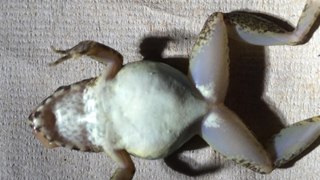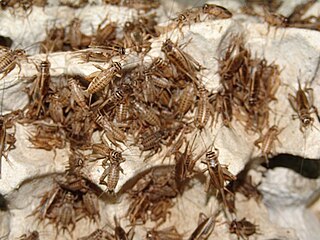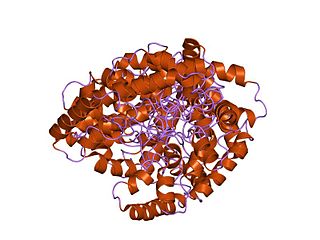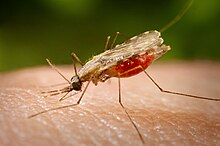
Mosquitoes are members of a group of almost 3,600 species of small flies within the family Culicidae. The word "mosquito" is Spanish for "little fly". Mosquitoes have a slender segmented body, one pair of wings, one pair of halteres, three pairs of long hair-like legs, and elongated mouthparts.

Flies are insects of the order Diptera, the name being derived from the Greek δι- di- "two", and πτερόν pteron "wing". Insects of this order use only a single pair of wings to fly, the hindwings having evolved into advanced mechanosensory organs known as halteres, which act as high-speed sensors of rotational movement and allow dipterans to perform advanced aerobatics. Diptera is a large order containing an estimated 1,000,000 species including horse-flies, crane flies, hoverflies and others, although only about 125,000 species have been described.

Ovoviviparity, ovovivipary, ovivipary, or aplacental viviparity is a term used as a "bridging" form of reproduction between egg-laying oviparous and live-bearing viviparous reproduction. Ovoviviparous animals possess embryos that develop inside eggs that remain in the mother's body until they are ready to hatch.

Among animals which produce eggs, the yolk is the nutrient-bearing portion of the egg whose primary function is to supply food for the development of the embryo. Some types of egg contain no yolk, for example because they are laid in situations where the food supply is sufficient or because the embryo develops in the parent's body, which supplies the food, usually through a placenta. Reproductive systems in which the mother's body supplies the embryo directly are said to be matrotrophic; those in which the embryo is supplied by yolk are said to be lecithotrophic. In many species, such as all birds, and most reptiles and insects, the yolk takes the form of a special storage organ constructed in the reproductive tract of the mother. In many other animals, especially very small species such as some fish and invertebrates, the yolk material is not in a special organ, but inside the egg cell.
Autogenesis may refer to:

Oviparous animals are animals that lay their eggs, with little or no other embryonic development within the mother. This is the reproductive method of most fish, amphibians, most reptiles, and all pterosaurs, dinosaurs, and monotremes.
Vitellogenin is a precursor of egg yolk that transports protein and some lipid from the liver through the blood to the growing oocytes where it becomes part of the yolk. Normally, it is only found in the blood or hemolymph of females, and can therefore be used as a biomarker in vertebrates of exposure to environmental estrogens which stimulate elevated levels in males as well as females. "Vitellogenin" is a synonymous term for the gene and the expressed protein. The protein product is classified as a glycolipoprotein, having properties of a sugar, fat and protein. It belongs to a family of several lipid transport proteins.

The Phlebotominae are a subfamily of the family Psychodidae. In several countries, their common name is sandfly; but that name is also applied to other flies. The Phlebotominae include many genera of blood-feeding (hematophagous) flies, including the primary vectors of leishmaniasis, bartonellosis and pappataci fever. In the New World, leishmaniasis is spread by sand flies in the genus Lutzomyia, which commonly live in caves, where their main hosts are bats. In the Old World, sand flies in the genus Phlebotomus spread leishmaniasis.

Proteins are essential nutrients for the human body. They are one of the building blocks of body tissue and can also serve as a fuel source. As a fuel, proteins provide as much energy density as carbohydrates: 4 kcal per gram; in contrast, lipids provide 9 kcal per gram. The most important aspect and defining characteristic of protein from a nutritional standpoint is its amino acid composition.

The Culicinae are the most extensive subfamily of mosquitoes (Culicidae) and have species in every continent except Antarctica, but are highly concentrated in tropical areas. Mosquitoes are best known as parasites to many vertebrate animals and vectors for disease. They are holometabolous insects, and most species lay their eggs in stagnant water, to benefit their aquatic larval stage.

Vitellogenesis is the process of yolk protein formation in the oocytes of non mammalian vertebrates during sexual maturation. The term vitellogenesis comes from the Latin vitellus. Yolk proteins, such as Lipovitellin and Phosvitin, provides maturing oocytes with the metabolic energy required for development. Vitellogens are the precursor cells that lead to yolk protein synthesis in the oocyte. Estrogen and vitellogenin production have a positive correlation. When estrogen production in the ovary is increased via the activation of the hypothalmo-pituitary axis it leads to heightened vitellogenin production in the liver. Vitellogenin production in the liver is the first step of vitellogenesis. Once Vittelogenins are released into the blood stream where they are then transported to the growing oocyte where they lead to yolk protein production. The transport of vitellogenins into the maturing oocyte is done via receptor mediated endocytosis which is a low density lipoprotein receptor (LDLR). Yolk is a lipoprotein composed of proteins, phospholipids and neutral fats along with a small amount of glycogen. The yolk is synthesised in the liver of the female parent in soluble form. Through circulation it is transported to the follicle cells that surround the maturing ovum, and is deposited in the form of yolk platelets and granules in the ooplasm. The mitochondria and Golgi complex are said to bring about the conversion of the soluble form of yolk into insoluble granules or platelets.

Humans and human ancestors have scavenged and eaten animal eggs for millions of years. Humans in Southeast Asia had domesticated chickens and harvested their eggs for food by 1,500 BCE. The most widely consumed eggs are those of fowl, especially chickens. Eggs of other birds, including ostriches and other ratites, are eaten regularly but much less commonly than those of chickens. People may also eat the eggs of reptiles, amphibians, and fish. Fish eggs consumed as food are known as roe or caviar.

Lactation describes the secretion of milk from the mammary glands and the period of time that a mother lactates to feed her young. The process naturally occurs with all sexually mature female mammals, although it may predate mammals. The process of feeding milk in all animals is called nursing, and in humans it is also called breastfeeding. Newborn infants often produce some milk from their own breast tissue, known colloquially as witch's milk.

Insect farming is the practice of raising and breeding insects as livestock, also referred to as minilivestock or micro stock. Insects may be farmed for the commodities they produce, or for them themselves; to be used as food, as feed, as a dye, and otherwise.

Hematophagy is the practice by certain animals of feeding on blood. Since blood is a fluid tissue rich in nutritious proteins and lipids that can be taken without great effort, hematophagy is a preferred form of feeding for many small animals, such as worms and arthropods. Some intestinal nematodes, such as Ancylostomatids, feed on blood extracted from the capillaries of the gut, and about 75 percent of all species of leeches are hematophagous. The spider Evarcha culicivora feeds indirectly on vertebrate blood by specializing on blood-filled female mosquitoes as their preferred prey. Some fish, such as lampreys and candirus, and mammals, especially the vampire bats, and birds, such as the vampire finches, hood mockingbirds, the Tristan thrush, and oxpeckers also practise hematophagy.

In molecular biology, the crustacean neurohormone family of proteins is a family of neuropeptides expressed by arthropods. The family includes the following types of neurohormones:
Alexander S. Raikhel is a distinguished professor of entomology at the University of California, Riverside, and an elected member of the United States National Academy of Sciences.

Many species of flies of the two-winged type, Order Diptera, such as mosquitoes, horse-flies, blow-flies and warble-flies, cause direct parasitic disease to domestic animals, and transmit organisms that cause diseases. These infestations and infections cause distress to companion animals, and in livestock industry the financial costs of these diseases are high. These problems occur wherever domestic animals are reared. This article provides an overview of parasitic flies from a veterinary perspective, with emphasis on the disease-causing relationships between these flies and their host animals. The article is organized following the taxonomic hierarchy of these flies in the phylum Arthropoda, order Insecta. Families and genera of dipteran flies are emphasized rather than many individual species. Disease caused by the feeding activity of the flies is described here under parasitic disease. Disease caused by small pathogenic organisms that pass from the flies to domestic animals is described here under transmitted organisms; prominent examples are provided from the many species.

As in the human practice of veganism, vegan dog foods are those formulated with the exclusion of ingredients that contain or were processed with any part of an animal, or any animal byproduct. Vegan dog food may incorporate the use of fruits, vegetables, cereals, legumes including soya, nuts, vegetable oils, as well as any other non-animal based foods.
Aedes taeniorhynchus, or the black salt marsh mosquito, is a mosquito in the family Culicidae. It is a carrier for encephalitic viruses including Venezuelan equine encephalitis and can transmit Dirofilaria immitis. It resides in the Americas and is known to bite mammals, reptiles, and birds. Like other mosquitoes, Ae. taeniorhynchus adults survive on a combination diet of blood and sugar, with females generally requiring a blood meal before laying eggs.
















